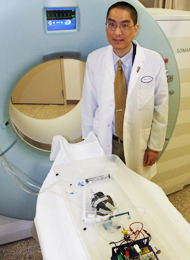Feature Story
Health Center Today, June 7, 2011
Practice Makes Perfect – And Helps Avoid Unnecessary Exams
By Carolyn Pennington

Dr. Clifford Yang is the creator of a device that simulates a beating heart for use in training technologists in cardiac imaging.
Photo by Chris DeFrancesco
Dr. Clifford Yang, assistant professor of radiology and medicine (cardiology), likes to compare the phantom – a new heart model he has developed - to a flight simulator. Like a pilot who is able to test his flying abilities before he actually leaves the ground, a technologist is able to perfect his scanning techniques before imaging a living, breathing patient.
Cardiac computed tomography angiography (CTA) is the use of CT to evaluate the coronary arteries for atherosclerotic disease, the number one cause of death in the U.S.
“A technologist has one chance to do a cardiac CTA image correctly due to the radiation and intravenous contrast dose,” says Yang. “If you do a cardiac CT poorly, the patient will need an unnecessary invasive coronary angiogram to revaluate the coronary arteries.”
The radiation dose for cardiac CT is the highest of the CT exams so that’s why getting the exam right the first time is so important.
On-the-job training can be difficult since the Health Center may have only one or two cardiac CT patients a week. Larger hospitals that scan more patients may also have issues since they have even more doctors they need to train.
“Now that we have a model we can scan as many times as we want until the new technologist gets comfortable with it,” says Yang.
The first heart model Yang developed was made of clay and other materials. He took the model to the American College of Radiology’s national conference where he showed it to two nationally known cardiac radiologists. Their reaction was extremely positive.
“I was surprised at the reaction that I got. They really liked the idea a lot,” says Yang. “But it was an anatomic model and one of them asked me whether I could make an electrical model that beats like a regular heart. That set me back to square one.”
So for the next six months Yang spent a lot of time in the basement of his house developing the current device which is a functional model of the heart. (Dr. Yang has made a video showing the phantom in action). The heart rate can be changed on the model so the technologist can adjust it and scan again. Cardiac CTA protocol modifications can also be tested on the phantom, which can’t be easily done on living patients.
Yang is working with UConn’s Center for Science and Technology Commercialization which has filed a provisional patent application on the device. They have also begun contacting companies to determine if any are interested in licensing the technology.
Yang is also scheduling talks about the phantom, starting with radiologists and cardiologists at Brigham and Women’s Hospital in Boston.
For a lecture or demonstration of the device, please contact Dr. Clifford Yang at cyang@uchc.edu or 860 679 1458.


